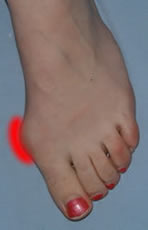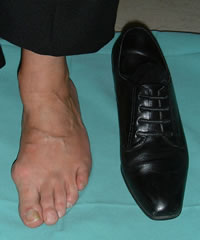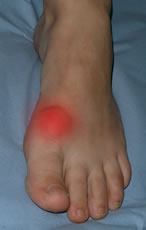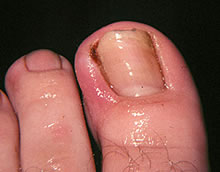Pain in the big toe is a common complaint. It's often put down to a "bunion", and patients are referred with a request for removal of the bunion. Although hallux valgus is, indeed, one of the commonest problems in the foot, not all hallux pain comes from a bunion.
What sort of problem is it?

True bunion pain - medial abrasion from hallux valgus
- pain on the medial side is usually due to abrasion on the shoe in hallux valgus
- pain over the dorsum of the MTP joint is often due to arthritis in the joint (hallux rigidus) - sometimes it’s mainly coming from the joint itself, sometimes it’s caused by abrasion of the tissues between a dorsal osteophyte and the shoe
- pain along the side of the nail is usually caused by an ingrowing toenail, or less often by a subungual exostosis growing under the nail
- pain under the toe may be due to excess pressure when walking, or to a sesamoid problem, MTP or IP joint arthritis or synovitis of FHL.
- pain all over the toe can be referred from an arthritic joint, or infection, but is often neuritic pain from a local nerve irritation, regional pain syndrome or L5 radiculopathy
Making it clearer

This foot cannot fit comfortably into this shoe. Make the shoe fit the foot, not the foot fit the shoe!

Dorsal pain and osteophyte in hallux rigidus

Lateral nail fold pain caused by an ingrowing toenail
Pain under the nail itself can be due to fungal infection - ask about fungal infection elsewhere in the foot. Subungual exostoses can press under the nail but often present in the nail fold and can be mistaken for ingrowing toenails. There is sometimes a history of trauma with an exostosis. Pain under the nail can also be caused by infection in the phalanx itself and rarely by nail bed tumours, especially melanomas. Infection and tumours tend to cause increasing pain that is unaffected by position and may be present at night and insensitive to simple analgesia. With infection there may be a history of injury or (in neuropathic patients) ulceration and the person may describe fever, sweating or shaking.
Pain under the toe may come from pressure, an arthritic MTP joint or from one of the sesamoids. Increased pressure under the 1st metatarsal head often causes calluses which the patient may indicate as the site of pain. Ask about other sites of pressure, whether the patient has noticed anything odd about the shape of their foot or the way they walk. People with cavus feet often have pressure under a plantarflexed first ray, and cavus tends to run in families even if there is no definite neurological cause, so make a point of asking whether anyone else in the family has foot problems.
Sesamoid pain is usually reasonably localised to the sesamoid bone but it often takes some questioning to clarify this. Pain further down the plantar surface of the toe may be due to FHL synovitis, IPJ arthritis or skin or deep infection - again, questioning is mainly directed at localising the maximum pain to guide examination.
Pain all over the toe can be difficult to diagnose. Commonly it is referred from an arthritic MTP joint and direct questioning identifies the joint line as the site of maximum pain. If the patient has had surgery or an injury, neuritic pain or complex regional pain syndrome can cause pain all over the toe and sometimes involving the foot too. An L5 radiculopathy, often due to a L4/5 disc prolapse or root canal stenosis, can cause pain in the big toe and the medial foot, often with tingling or numbness. Nerve pain has a severe, burning, throbbing character and may have other neurological symptoms. Regional pain syndrome often has swelling, colour changes and sweating in the early stages. Generalised throbbing, swelling and redness can also be due to skin or deep infection and the person should be asked about injury, immune competence, circulation and neuropathy.
Remember to ask general questions about health and systemic conditions that can affect the foot.
"Before it gets any worse…"
Some patients are brought to the clinic not because of what their feet are like now, but because of concern about what they may become like, based on the experience of mother or grandmother. Ask about any background that may have exacerbated mother's feet (especially inflammatory arthritis). Unless the index patient has very severe hallux valgus with incongruity at a young age, when it may be best to offer at least a holding procedure, it is best to treat the feet on their own merits and take the opportunity for some education about shoes.
Reviewing the history
By asking relevant questions you will usually have a good idea of the most likely cause of pain, which you can sort out further by examination. Sometimes there will be one or two possibilities, or you may be considering a combined diagnosis such as hallux valgus with arthritis of the MTP joint. Again, examination should be focused on clarifying such diagnoses.
